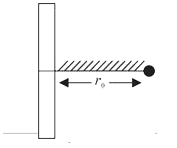A particle of mass 400mg and charged with 5×10−9C is moving directly towards a fixed positive point charge of magnitude 10−8C. When it is at a distance of 10 cm from the fixed positive point charge it has a velocity of 50 cm/s. At what distance from the fixed point charge will the particle come momentarily to rest ? Is the acceleration constant during the motion ?
If the particle comes to rest momentarily at a distance r from the fixed charge, then from conservation of energy' we have
12mu2+14πε0Qqa=14πε0Qqr
Substituting the given data, we get
12×40×10−6×12×12
=9×109×5×10−8×10−9[1r−10]
or, 1r−10=5×10−69×5×10−8=1009⇒1r=1909
⇒r=9190m
or, i.e., r=4.7×10−2m
As here, F=14πε0Qqr2
so acc. =Fm∝1r2
i.e., acceleration is not constant during the motion.
Topper's Solved these Questions
- ELECTROSTATICSBook:MOTIONChapter:ELECTROSTATICSExercise:SELF MISCELLANEOUS PROBLEM (Example )
Explore 15 Videos
- ELECTROSTATICSBook:MOTIONChapter:ELECTROSTATICSExercise:SELF PRACTICE PROBLEM
Explore 27 Videos
- ELECTRONICS - SEMI CONDUCTORBook:MOTIONChapter:ELECTRONICS - SEMI CONDUCTORExercise:EXERCISE - 3
Explore 29 Videos
- ELECTROSTATICS - I Book:MOTIONChapter:ELECTROSTATICS - I Exercise:EXERCISE - 4 (Level -II) PREVIOUS YEAR - JEE ADVANCED
Explore 13 Videos
Similar Questions
A particle of mass 40 mg and carrying a charge 5×10−9C is moving directly towards a fixed positive point charge on magnitude 10−8C. When it is at a distance of 10 cm from the fixed positive point charge it has a velocity of 50cms−1 at what distance from the fixed point charge will the particle come momentarily to rest ? Is the acceleration constant during motion?
View SolutionA charged particle (q,m) is moving directly towards fixed positive charge Q. When it is at distance d from Q, it has speed v0. At what distance Q will be particle come momentarily to rest ? Is the acceleration constant during motion ?
View Solution
Knowledge Check
Two positive charges of magnitude 4C and 6C are placed 10cm apart . The electric potential at a distance of 10cm from the middle point on the right bisector of the line,joining the two charges is
A5×1011VB4×109VC8×1011VD5×109VA particle A of mass m and charge Q moves directly towards a fixed particle B, which has charge Q. The speed of A is a v when it is far away from B. The minimum separtion between the particles is not proportional to
AQ2B1v2C1vD1m
Two point charge Q and 4Q are fixed at a distance of 12cm from each other. Sketch lines of force and locate the neutral point, if any .
View SolutionA particle of mass 100 gm and charge 2μC is released from a distance of 50 cm from a fixed charge of 5μC. Find the speed of the particle when its distance from the fixed charge becomes 3 m.
View SolutionA particle of mass 100 gm and charge 2μC is released from a distance of 50 cm from a fixed charge of 5μC. Find the speed of the particle when its distance from the fixed charge becomes 3 m.
View SolutionA positive point charge is released from rest at a distance r0 from a positive line charge with uniform density. The speed (v) of the point charge, as a function of instantaneous distance r from line charge, is proportional to:

View SolutionTwo point charges of +2×10−8C are placed 6 apart. Determine the force on a point charge of +1×10−8C placed at a distance of 5 cm from each of the two given charges.
View SolutionThe magnitude of electric field intensity due to a point charge is 10 N/C at a distance 1 m from it. Calculate the magnitude of charge.
View Solution